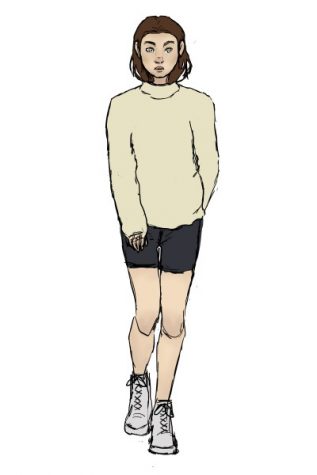Normcore fashion makes dressing like you don’t care incredibly difficult
November 14, 2018

Looking like you don’t care is an art form. Perfectly-mussed hair, no-makeup makeup and painstakingly-scuffed boots – all of these are hallmarks of the idea that to look our best. We must look like we’ve done nothing – perfectly. Today, this art form has a new name: normcore. Normcore fashion and attitudes all revolve around the idea of fitting in. You want to become one with the crowd, fit the standard so hard that you might as well not be there – but you must look unremarkably remarkable, otherwise you have failed.
Normcore is touted by many fashion editors and designers as a break from the carefully pressed and perfectly styled looks that they have been stifled by for so long. This isn’t the first time a rulebook of fashion has come from the desire to do away with the rulebook entirely: the rise of grunge, while also not the beginning, was one of the best-remembered “antithetical” trends to have sprung from this mentality.
Grunge fashion was a rebellion against the standards of the 1990s’ bubblegum-sweet styles. There was an emphasis upon self-expression in grunge, with loose-fitting clothing, chunky boots and an uncoordinated air unifying them, all with an edge that was otherwise lacking in the styles of the decade. There was an embrace of androgyny in grunge fashion, led in part by Kurt Cobain, where men wore dresses and skirts just as frequently as women, and women pulled on thrift store finds buried deep in the men’s sections. It was a counterculture movement. By contrast, normcore is only counterculture in name.
Normcore in fashion is best defined by looking at Jerry Seinfeld from the 1990s. If you had to define his style, would you be able to? Or would you just look at him in a crowd from the 1990s and shrug? The styling isn’t very removed from the grunge movement but lacks the individuality that made grunge appeal to so many. The emphasis has flipped.
While grunge embraced self-expression, normcore rejects it. Instead of men wearing dresses, the clothing that embodies the trend is unisex. Unisex, in the terms of normcore, leans towards an emphasis on masculine, boxy clothing, made to look good on a hanger and only on certain bodies. Instead of allowing whomever to wear whatever, normcore forces everyone to wear the same clothes.
Price point has also changed from grunge to normcore. While grunge was embraced late in the ‘90s by high-fashion houses, it was still accessible to people who couldn’t afford $500 shirts. Normcore, by contrast, is almost entirely characterized by high price points. While some pieces that may fall under the normcore umbrella can be found in your local Goodwill, it’s far more likely that the chunky white sneakers you’ve been seeing on and off runways cost more than your monthly rent. Normcore is performance art, reaching into your pockets to seem like you didn’t try at all.
Or is its exclusivity more than just perceived? I see people in my Instagram feed, walking around campus, that wear normcore every day. Mid-length biker shorts, hugely oversized sweatshirts, chunky sneakers and a blasé attitude about it all. There’s one uniting factor about these people who get hundreds of likes and dozens of comments on their posts of clothes that are, realistically, ugly: white, pretty, skinny and affluent. Anyone outside this circle would immediately get labeled as not trying, while if they fit the aforementioned criteria, they get a pass – they’re probably just “normcore, you know? They’re totally channeling Seinfeld.”
Not trying – looking sloppy, uncoordinated, unstylish, whatever you want to say – is a disqualifier for so many people. For people who aren’t rail-thin, having an off day isn’t as simple as saying, “Oh, I don’t want to wear this super tight shirt today, I guess I’ll just throw on this oversized tee.” They’ve got to consider how society will judge them, as does everyone else outside what is considered the norm.
The central thesis of normcore is not caring about how you look, and therefore, not trying – but trying to make sure that you don’t care takes far more effort than one would think. You must be pretty despite your clothes, not because of them.
Normcore likes to pretend that it’s for everyone, then ridicules those who dare to engage without fitting their profile. While normcore started as a rebellion against body-policing and the strict standards women and men had to fit, it’s now become its own rigorous dogma, another set of rules that you have to follow. Normcore is just a new version of ‘90s grunge but “elevated” in a way that takes away the accessibility that grunge had for the “other” in society. It’s looking perfectly imperfect, putting so much effort into something that looks so intentionally wrong that it looks like a conscious choice – but lord forbid anyone know you’ve done it.



















Martine • Dec 25, 2018 at 1:30 pm
Grunge did not do a lot for individuality. When everyone wears a plaid shirt around the waist, and leather jacket, no one stands out. In fact the reason for Normcore is to point out that the counter culture has been the mainstream culture for many decades. The standard movie hero is a antisocial hipster who is shunned by the Hollywood version of the incrowd of mean popular preppies which don’t exist in real life. In order to rebel, you would pretty much have to rebel against grunge. Which is exactly what people are doing. Rebelling against the typical sensitive, Doc Marten wearing Hollywood highschool hero.